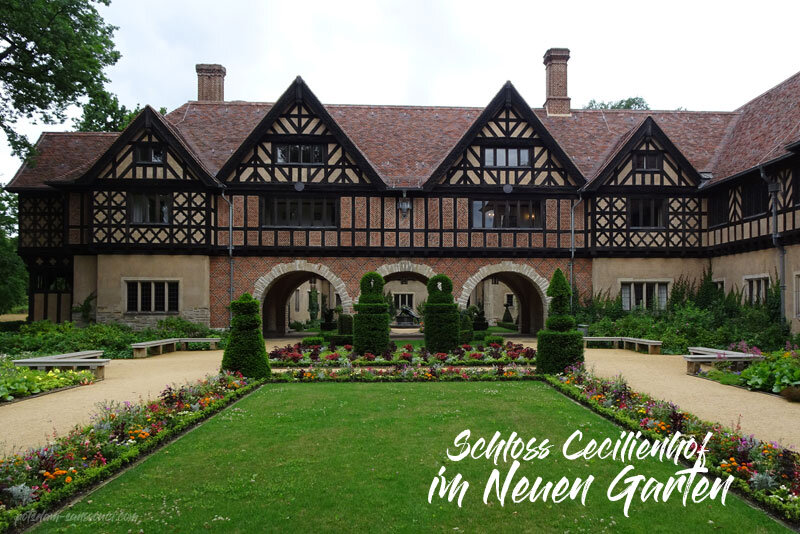Cecilienhof Palace

The Cecilienhof Palace, built between 1913 and 1917 in the northern part of the New Garden in Potsdam, gained fame through the Potsdam Conference held here. Today, the palace serves as a memorial and is among the prominent attractions in Potsdam. Here, you can find additional information about this historical palace as well as details about tickets.
Table of contents
Cecilienhof Palace: Last Palace of the Hohenzollerns
With 176 rooms, Cecilienhof Palace stands as the last and most modern Hohenzollern palace. Its history dates back to 1913-1917 when it was commissioned by Kaiser Wilhelm II and constructed under the supervision of the architect Paul Schultze-Naumburg. Originally intended as the residence for Crown Prince Wilhelm and his wife Cecilie, after whom the palace is named, Cecilienhof transcended its initial purpose.
The significance of Cecilienhof Palace extends far beyond its role as a royal residence, particularly during the period from August 17 to August 2, 1945, when it hosted the Potsdam Conference. In the impressive conference hall, once a residential space, the victorious powers of World War II gathered to negotiate the fate of Germany and shape the post-war European order. These historic events firmly etch Cecilienhof Palace into the annals of history, bestowing upon it a unique cultural importance.
Today, the palace not only stands as a witness to bygone eras but also serves as a striking monument to historical events and a significant landmark in Potsdam.
Architecture
The Palace presents itself as a two-story structure, combining brick and timber framing in the charming English country house style. This architectural design imparts a particularly idyllic aesthetic to the palace, seamlessly blending with its surroundings in the New Garden in Potsdam.
The palace encompasses a total of 176 rooms, tastefully arranged around five picturesque courtyards. These inner courtyards not only create a charming atmosphere but also lend Cecilienhof Palace a unique structure that intricately connects the history and function of its various spaces. Each courtyard contributes to the overall composition of the palace, allowing visitors to immerse themselves in a captivating world of architecture and history.
The original construction and clever arrangement of rooms make Cecilienhof Palace an outstanding example of the art of castle architecture, while the inner courtyards provide an inviting and picturesque backdrop for historical experiences.
Interior of Cecilienhof Palace
On the ground floor of the central building, there once extended representative living spaces that, through their magnificent furnishings, provided a glimpse into the luxurious lifestyle of bygone eras. Additionally, on the upper floor were the private sleeping quarters, dressing rooms, and bathrooms, forming the intimate retreat for the residents.
The historical significance of Cecilienhof Palace is particularly emphasized by the events during the Potsdam Conference in 1945. In preparation for this historic meeting, all furniture and furnishings on the ground floor were removed by the Soviets to make room for the redesign of the spaces for the conference participants. The entire inventory was relocated to the Alte Meierei on the shore of Lake Jungfern. Unfortunately, the original furnishings were destroyed by fire in July 1945, resulting in the irretrievable loss of a significant part of the palace’s history. Despite this loss, Cecilienhof Palace endures as a witness to political history and as an impressive architectural masterpiece.
Living Hall
The central axis of the main building features an impressive Great Hall that spans an astounding 26 meters and reaches a height of two stories. This imposing hall, originally conceived as a residential space, serves as the focal point of Cecilienhof Palace. Characterized by wooden paneling on the walls, visible wooden beam constructions on the ceiling, and a generous grid-patterned window facade, its design encapsulates the enchanting English country house style of the era.
In days gone by, the living hall was adorned with comfortable furnishings, imparting a touch of luxury and elegance. A particular highlight was the intricately carved Danzig Baroque staircase, leading to the private quarters of the Crown Prince and Princess and serving as a gift from the city of Danzig, highlighting a historical connection.
The former living hall underwent a significant transformation during the Potsdam Conference when it was converted into an impressive conference hall. This not only underscores the versatility of Cecilienhof Palace but also emphasizes its historical significance in the context of globally significant political events.
Special Exhibition “Potsdam Conference 1945 – Reorganization of the World”
Currently, there is a special exhibition at Cecilienhof Palace focusing on the Potsdam Conference.
Opening Hours
Tuesday to Sunday: 10:00 am to 5:30 pm
Guided Tours, Visits, and Tickets for Cecilienhof Palace
| Note: In November 2024, the renovation of the hotel areas and the visitor reception at Schloss Cecilienhof will begin, following the restoration of the facades and roofs that took place between 2014 and 2017. The work, which is expected to last until autumn 2027, will require the closure of the castle to the public starting November 1, 2024. |
1 Ticket – 11 Palaces: includes entry to Cecilienhof Palace
Tours, Guided Tours, and Tickets around Cecilienhof Palace can also be found with our partner GetYourGuide.
For additional options and convenience, explore tours, guided experiences, and ticket offerings for Cecilienhof Palace through our partner GetYourGuide.
Beside Cecilienhof Palace, there are many other top attractions to explore in Potsdam. You can find related tours and tickets here.
Take your time to discover Potsdam. Consider planning a multi-day trip to Potsdam. For your accommodation, we have compiled a selection of the best hotels in Potsdam.
Address
Im Neuen Garten 11 14469 Potsdam
Pictures of Cecilienhof Palace
Explore visual impressions of the Palace in the image gallery below:
